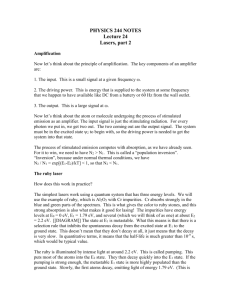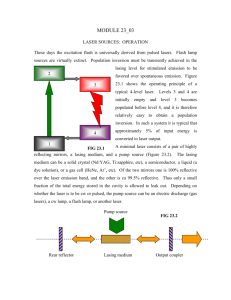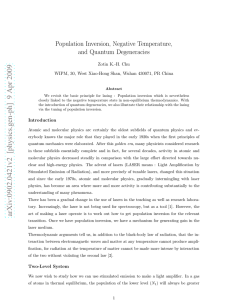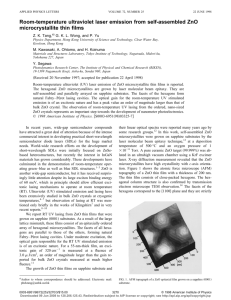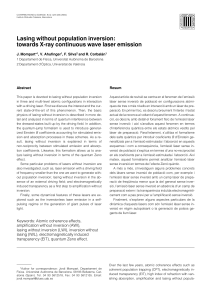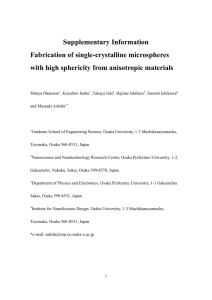Lecture 25
advertisement
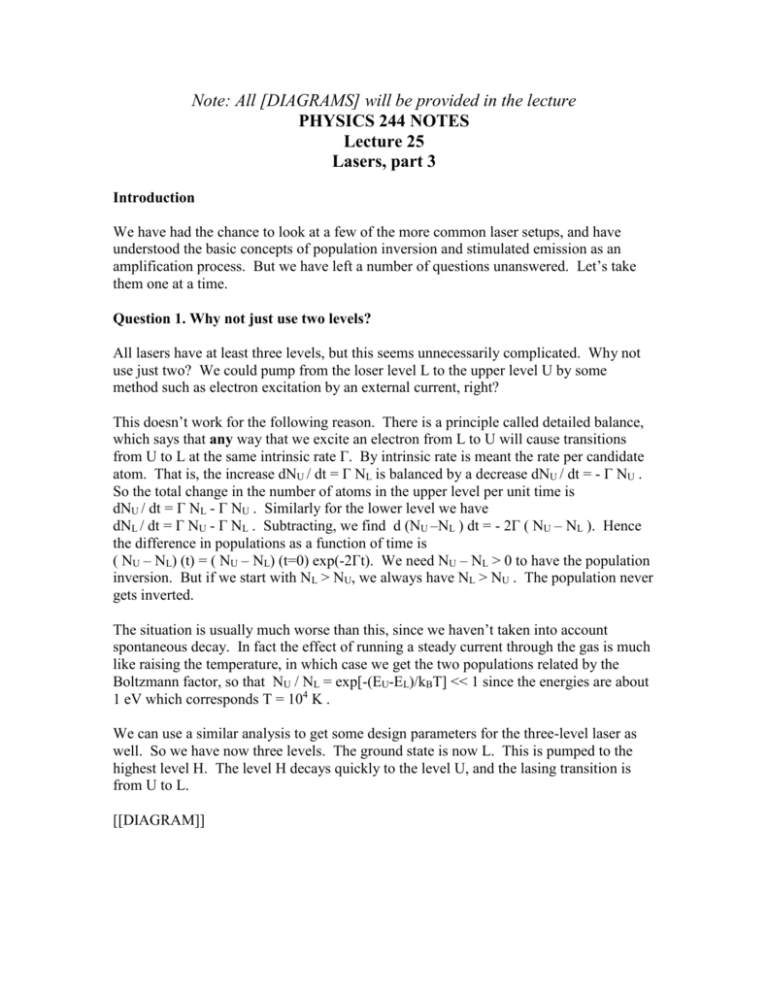
Note: All [DIAGRAMS] will be provided in the lecture PHYSICS 244 NOTES Lecture 25 Lasers, part 3 Introduction We have had the chance to look at a few of the more common laser setups, and have understood the basic concepts of population inversion and stimulated emission as an amplification process. But we have left a number of questions unanswered. Let’s take them one at a time. Question 1. Why not just use two levels? All lasers have at least three levels, but this seems unnecessarily complicated. Why not use just two? We could pump from the loser level L to the upper level U by some method such as electron excitation by an external current, right? This doesn’t work for the following reason. There is a principle called detailed balance, which says that any way that we excite an electron from L to U will cause transitions from U to L at the same intrinsic rate Γ. By intrinsic rate is meant the rate per candidate atom. That is, the increase dNU / dt = Γ NL is balanced by a decrease dNU / dt = - Γ NU . So the total change in the number of atoms in the upper level per unit time is dNU / dt = Γ NL - Γ NU . Similarly for the lower level we have dNL / dt = Γ NU - Γ NL . Subtracting, we find d (NU –NL ) dt = - 2Γ ( NU – NL ). Hence the difference in populations as a function of time is ( NU – NL) (t) = ( NU – NL) (t=0) exp(-2Γt). We need NU – NL > 0 to have the population inversion. But if we start with NL > NU, we always have NL > NU . The population never gets inverted. The situation is usually much worse than this, since we haven’t taken into account spontaneous decay. In fact the effect of running a steady current through the gas is much like raising the temperature, in which case we get the two populations related by the Boltzmann factor, so that NU / NL = exp[-(EU-EL)/kBT] << 1 since the energies are about 1 eV which corresponds T = 104 K . We can use a similar analysis to get some design parameters for the three-level laser as well. So we have now three levels. The ground state is now L. This is pumped to the highest level H. The level H decays quickly to the level U, and the lasing transition is from U to L. [[DIAGRAM]] We can write a set of equations for the populations again: dNL / dt = - Γ NL + γUL NU + γHL NH dNU / dt = - γUL NU + γHU NH dNH / dt = Γ NL – ( γHL + γHU ) NH The small γ’s represent optical transition rates, while the big Γ is the pumping rate as before. We find a steady state solution dNL / dt = dNU / dt = dNH / dt = 0: - ΓLH NL + γUL NU + γHL NH = 0 - γUL NU + γHU NH =0 ΓLH NL – ( γHL + γHU ) NH =0 with a population inversion NU > NL only if ΓLH > γUL ( 1 + γHL / γHU) . The way to get this is to make sure that two requirements are fulfilled: (1) γHL / γHU << 1 so we choose a metastable state for U. If we don’t do this then the system will revert to the two-level case. (2) ΓLH > γUL All this says is that the pumping rate must be higher than the rate for the laser transition. This is certainly clear, since the principle of energy conservation tells us that the power input must exceed the laser output. Question (2). Why can’t we use a three-level system with the two higher levels as the laser levels? Answer: you can. He-Cd lasers are of this kind. The analysis is pretty similar to the ruby laser. We want a fast decay from the lower lasing level to the ground state and a high pumping rate. Question (3). Why use four levels? In other words why go from the relatively simple scheme of the ruby laser to more complicated HeNe scheme? Let the four levels be labeled 0, L, U, H in increasing order of energy. In this case, we can also write the four rate equations, and derive two criteria for laser operation, but this would take us further than we want to go. We will just state the main condition for laser operation: Γ > γ0L γUL / γL0. Here 0 is the ground state, U and L are the upper and lower lasing states, and Γ is the pumping rate from 0 to the to the highest state H(or group of states, usually). Normally γ0L / γL0 << 1, since γL0 includes spontaneous decay. This means that the pumping requirements are very much less than for the three-level system. The key point is that the population inversion is helped by the fact that the lower lasing level L is depopulated spontaneously – it drains into the 0 level. Question (4) Why use a cavity? Why not just send a beam into a gas or other medium that has been pumped so that it has a population inversion? This is a question of gain, as in any amplifier. The gain increases with every pass in the cavity, so it is much cheaper to have the cavity rather than a very long column of lasing medium.





